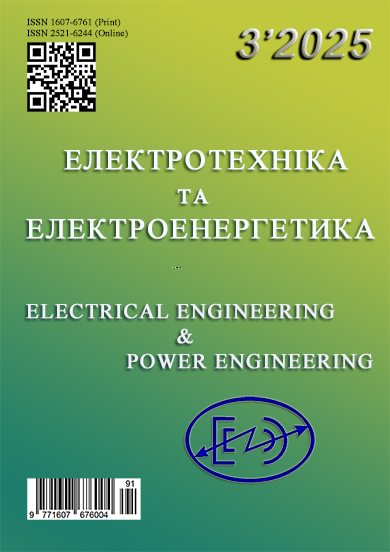Synthesis of a control system for a pulse current source of plasma arc
DOI:
https://doi.org/10.15588/1607-6761-2025-3-1Keywords:
PI controller, digital control systems, direct quality indicators, microcontroller, plasma arc, current stabilizer, power supplyAbstract
Purpose. To synthesize analytically astatic digital system for stabilizing the plasmatron arc current according to the given direct indicators of quality and order of astaticism. Based on a continuous prototype as a result of solving the problem of determining the desired transfer function of a closed system. In addition to the given regulation time (one of the main indicators), it is necessary to provide additional requirements for quality in transient modes.
Methodology. Computer simulation method, separation method – optimal filtering and optimal deterministic control and methods for adjusting regulators.
Findings. A linearized discrete mathematical model of a pulse converter is substantiated; the generalized parameters of this model are determined. According to this model, the synthesis of regulators of a digital plasma arc current control system is calculated, analyzed and presented.
Digital systems have higher manufacturability and reliability. However, the task of synthesizing digital systems is more difficult compared to a similar task in the continuous case. The article is devoted to solving the problem of synthesizing a discrete automatic plasma arc current stabilization system, the implementation of which is carried out on the basis of the principle of output and influence control with specified direct quality indicators. The effectiveness of the proposed methods is illustrated by quantitative examples.
Originality. The advantage of the considered method is that it can eliminate the methodological error in the synthesis of astatic digital systems caused by the discretization of the desired functions of continuous systems.
Practical value. The use of the implemented automated synthesis procedure allows: to increase the quality and productivity of developers at the stage of technical design of discrete control systems; to accelerate and automate the process of scientific research of digital control systems. The results presented in the work were used in the design of switching power supplies with current control.
References
Billings Keith and Taylor Morey. (2011). Switchmode Power Supply Handbook. 3rd ed. New York: McGraw-Hill Education. 1020.
Denisov Ju.A. (2001). Stabilizatory postojannogo na-prjazhenija s shirotno-impul'snymi i chastotno-impul'snymi kvazirezonansnymi preobrazovateljami. K.: In-t jelektrodinamiki NAN Ukrainy, 146.
Isaak Mayergoyz, Siddharth Tyagi. (2021). Pulse Width Modulation in Power Electronics. World Scientific Publishing Company. 420.
Gostev V.I., Steklov V.K.. (1998). Sistemy avtomaticheskogo upravlenija cifrovymi reguljatorami: Spravochnik. Kyi'v: Radioamator, 704.
Olsson G., Piani G. (1992). Computer Systems for Automation and Control. Prentice-Hall international series in systems and control engineering. Prentice-Hall. 428.
Gostev V.I., Hodolij D.A., Baranov A.A. (2000). Sintez cifrovyh reguljatorov sistem avtomaticheskogo upravlenija. Kiev: Tehnika, 575.
Isermann R. (1981). Digital Control Systems. Springer-Verlag, 566.
Vereshchago Y., Kostiuchenko V., Stohniienko Y., Yeremenko A., Kyrychenko O, Melnyk O. (2024). Modeling of Soft Switching Bridge Converter. 2024 IEEE 5th KhPI Week on Advanced Technology (KhPIWeek). 318-323. https://doi.org/10.1109/KhPIWeek61434.2024.10878069
Vereshhago Je.M., Kostjuchenko V.I., Novogrec'kyj S.M. (2023). Analiz peretvorjuvacha postijnogo strumu, shho pracjuje na plazmovu dugu. Electrical engineering and electromechanics, 5, 31–36. https://doi.org/10.20998/2074-272X.2023.5.05
Vereshhago Je.M., Kostjuchenko V.I., Stognijenko Je.V., Grjeshnov A.Ju.. (2024). Keruvannja dynamikoju impul'snogo peretvorjuvacha z m’jakym peremykannjam, shho pracjuje na dugove navantazhennja. Technical electrodynamics. 6. 21 – 30. https://doi.org/10.15407/techned2024.06.021
Tewari A. (2022). Modern Control Design With MATLAB and SIMULINK. John Wiley and Sons Ltd, 503.
Downloads
Published
How to Cite
Issue
Section
License
Copyright (c) 2025 Y.M. Vereshchago, V.I. Kostiuchenko, M.V. Dzhanhyrov, A.P. Yeremenko, Y.V. Stohniienko

This work is licensed under a Creative Commons Attribution-ShareAlike 4.0 International License.
Creative Commons Licensing Notifications in the Copyright Notices
Authors who publish with this journal agree to the following terms:
Authors retain copyright and grant the journal right of first publication with the work simultaneously licensed under aCreative Commons Attribution License that allows others to share the work with an acknowledgement of the work's authorship and initial publication in this journal.
Authors are able to enter into separate, additional contractual arrangements for the non-exclusive distribution of the journal's published version of the work (e.g., post it to an institutional repository or publish it in a book), with an acknowledgement of its initial publication in this journal.
Authors are permitted and encouraged to post their work online (e.g., in institutional repositories or on their website) prior to and during the submission process, as it can lead to productive exchanges, as well as earlier and greater citation of published work.

